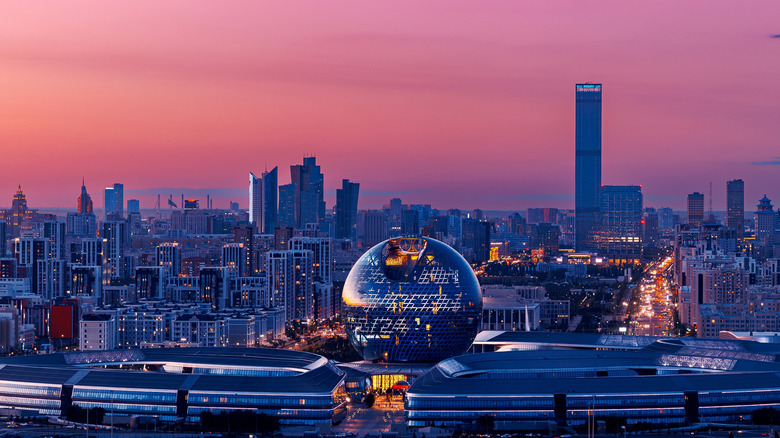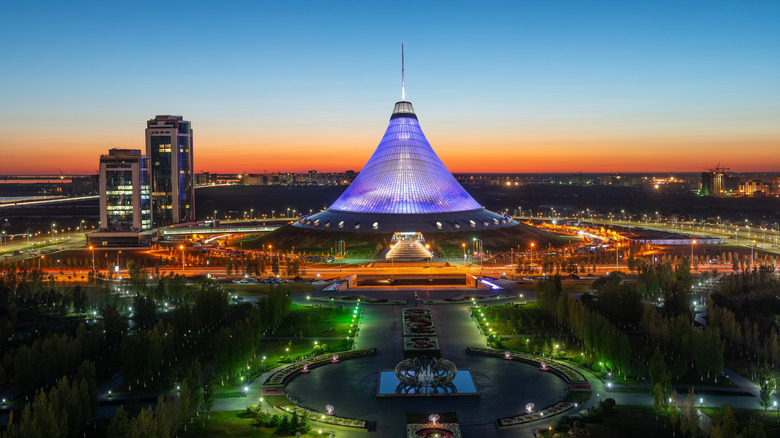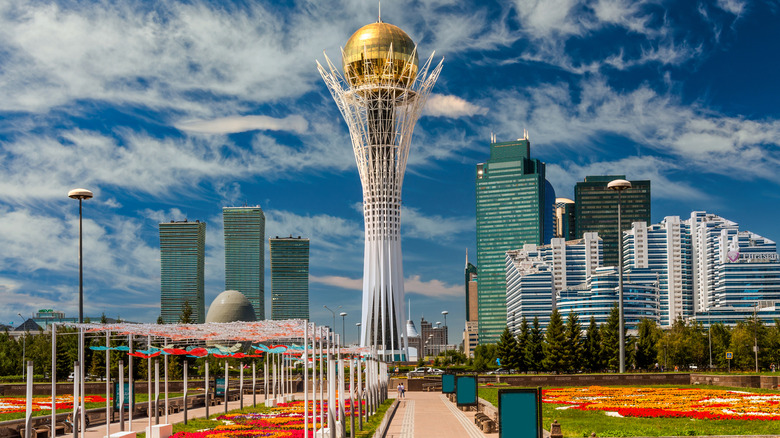'The World's Weirdest Capital City' Brims With Curious Architecture And Jaw-Dropping Tourist Attractions
Offbeat travel destinations don't always have to lead you into remote villages or wilderness. Sometimes going to a less-visited tourist destination will land you in a glittering city full of shiny buildings that walk the line between modern, experimental, and strange. Astana, one of the world's youngest capitals, became the official seat of Kazakhstan's central government in 1997 after the capital was moved from Almaty to the formerly remote town of Akmola, which would go on to become the hyper-modern Astana (a name that means "capital" in Kazakh). The city's name has changed as much as its personality, and it was briefly named Nur Sultan after the country's long-reigning president Nursultan Nazarbayev. Not only is the city the world's second coldest capital (after Mongolia's Ulaanbaatar) but it is also surrounded by hundreds of miles of vast grasslands that are iconic to Kazakhstan — the world's ninth largest country by area.
In Astana, massive skyscrapers of many different shapes sprout out of the stark, flat landscape. One of the most unique buildings in the city, the Baiterek Monument, is actually a 335-foot-tall tower inspired by the Kazakh legend of the tree of life. Interestingly, the building was initially sketched by the aforementioned Nursultan Nazarbayev. While these buildings led to CNN deeming Astana "The world's weirdest capital city," visiting Kazakhstan's capital offers the singular experience of exploring a new city boldly shedding its Soviet past. Whether you're visiting the museums and palaces or simply strolling its wide boulevards and admiring its surreal skyline, Astana is unlike any other city you may have visited.
Astana's weird modern architecture draws attention to the country's fascinating history
Astana's blazing-fast development and skyline replete with exotic shapes are largely funded by Kazakhstan's significant oil wealth. However, it isn't just a spending spree and wild attempt at modernism; there is symbolism behind it. The Khan Shatyr, a shopping and entertainment center that is housed in the world's largest tent, draws attention to the country's nomadic past. In fitting contrast, inside you will find high-end brands and even an indoor beach with white sand straight from the Maldives. Another staple of the skyline is the pyramid-shaped Palace of Peace and Reconciliation. This building was designed by Norman Foster and houses an opera house and a library. Just across the Ishim River, you can spot the Presidential Palace, which was designed to look like the White House.
Astana lets you explore a fascinating cross-section of Kazakhstan. The National Museum and the Museum of the Armed Forces both feature extensive exhibits from the country's ancient nomadic roots that go back thousands of years, and its history of conflict with the Mongol and Turkic armies. Signs of Kazakhstan's Soviet era, though not as apparent as they are in the former capital city of Almaty, still abound in the form of various old buildings and structures including a now-closed Soviet grain silo. The sprawling, newly built Hazrat Sultan Mosque features Kazakhstan's largest dome and can accommodate up to 10,000 people.
When visiting tourist sites in Kazakhstan, especially religious ones, pay attention to any protocols visitors must follow. If in doubt, ask and the country's friendly locals will be happy to help. Similar to Russia, where you should think twice before smiling at strangers, most people in Kazakhstan are not used to smiling at others and do not always enjoy it.
How to get around Astana and what to know before you go
Exploring Astana on foot isn't always easy since Kazakhstan is a country of vast distances, and its capital is no different. However, the city's main walking boulevard, Nurzhol Bulvar, is the exception. Adorned with flower gardens, fountains, and seating, the pathway features the Presidential Palace on one end and Khan Shatyr on the other with several iconic buildings in between, including the Baiterek Tower. The boulevard is a nod to the slow-living philosophy that has been incorporated into the city's design through public spaces made for relaxation and reflection. While not quite like Levanzo, the Italian island that's perfect for a slow-life vacation, you can still spend the day around Nurzhol Bulvar enjoying the sights and the dancing fountains on summer evenings.
Exploring the rest of the city will require transport. The local bus system works well, and there are various taxi apps available. You can also rent e-scooters and bicycles if you want more freedom to move around and explore the city. Considering that winter temperatures are well below freezing and the summer months are blistering hot, it's best to avoid the extreme seasons and visit Astana in May and June or September and October. Finding suitable accommodation for every budget is also very easy in the Kazakh capital. While you can get a great Airbnb for a relatively low price, if you decide a hotel is a better choice, consider looking into the city's many luxury hotels. Given Kazakhstan's relatively low accommodation prices, this is a great opportunity to experience a luxurious stay without the sticker shock.


